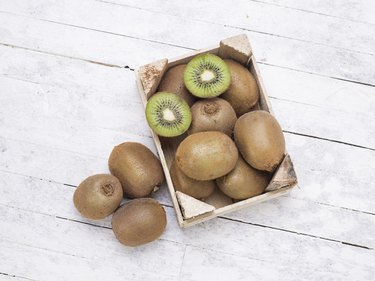
While bananas and apples are common options for people looking to add more fruit to their diet, the kiwi fruit should absolutely be part of your weekly rotation. A single fruit contains a number of important vitamins and minerals, including potassium, vitamin C, vitamin K and beta carotene.
Tip
The skin of the kiwi fruit is entirely edible, containing 50 percent more fiber than the interior. Eat it as is or blended into smoothies to remove the fuzzy mouthfeel.
Video of the Day
Read more: What Are the Benefits of Eating Kiwi Fruit?
Video of the Day
Origins of the Kiwi Fruit
Also called the Chinese gooseberry, the kiwi fruit originated in China before making its way to New Zealand. Now, however, it's grown all around the world, including South Africa and Chile. The majority of the kiwi fruit in America is grown in California.
Kiwi fruits are quite small, with black and white seeds and a soft green center. They're relatively sweet with a tangy aftertaste and are available year-round at most grocery stores. Eating the fruit fresh will help you gain all the nutritional benefits.
Kiwi Fruit Nutritional Benefits
According to the U.S. Department of Agriculture, one whole kiwi consists of 45 calories, 1 gram of protein, 11 grams of carbohydrates, 2 grams of fiber, 30 milligrams of calcium and 69 milligrams of vitamin C. The recommended amount of vitamin C for a young adult is 75 milligrams per day, so one kiwi provides almost the entire daily requirement and almost twice the amount found in oranges.
A 2018 study published in the European Journal of Nutrition determined that regular consumption of the kiwi fruit aids in digestion and has positive implications on common digestive issues such as irritable bowel syndrome.
A 2011 study published in the Asia Pacific Journal of Clinical Nutrition also stated that consuming two kiwi fruits before bed resulted in better sleep. These studies clearly show that the kiwi fruit can help in a range of different health conditions, several of which might not have been studied yet.
There is no limit to the number of kiwi fruits you can consume per day, but if you have an insulin sensitivity, it might be best to consume only one to two a day, due to their high sugar content.
Read more: Fiber in Kiwi Fruit
How to Eat Kiwi Fruit
Kiwi fruit can be eaten raw — in smoothies, as a yogurt topping, chopped into salads or even on its own as a snack. It's best not to cook the kiwi, because that can affect the vitamin C content.
While some believe they have to remove the skin of the kiwi fruit to eat it, in reality, the skin of the fruit is entirely edible, accounting for a high concentration of nutrients such as vitamin E, folate and fiber. In fact, by eating the kiwi fruit with skin, you'll be getting 50 percent more fiber.
Read more: Kiwi & Cholesterol
While the fuzzy skin may not look enticing, it actually doesn't taste bad at all, so don't be fooled. If you're not a fan of the texture, rubbing it with a towel can help remove the fuzz, while blending the entire fruit in a smoothie can help remove the strange mouthfeel.
- USDA Branded Food Products Database: "Kiwi Fruit"
- Asia Pacific Journal of Clinical Nutrition: "Effect of Kiwifruit Consumption on Sleep Quality in Adults With Sleep Problems"
- European Journal of Nutrition: "The Nutritional and Health Attributes of Kiwifruit: A Review"
- Blood Pressure: "The Effect of Kiwifruit Consumption on Blood Pressure in Subjects With Moderately Elevated Blood Pressure: A Randomized, Controlled Study"
- USDA FoodData Central: "Kiwi Fruit — Raw"
- California Rare Fruit Growers, Inc.: "Kiwifruit"
- NIH Office of Dietary Supplements: "Vitamin C"